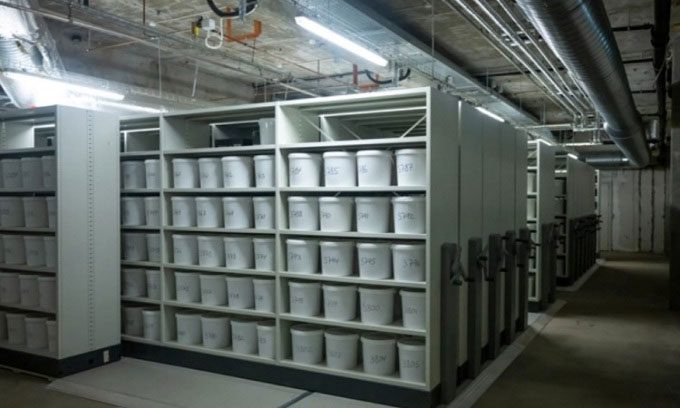Countless shelves line the walls of the basement at the University of Odense, housing 9,479 brains collected from patients with mental illnesses over four decades.

Buckets containing brain specimens from the collection. (Photo: AFP).
Preserved in large white buckets filled with formalin, the extensive collection of human brains at Odense is the lifelong work of renowned Danish psychiatrist Erik Stromgren. Beginning in 1945, this study was a form of experimental research, according to Jesper Vaczy Kragh, an expert in the history of psychiatry at the University of Copenhagen.
The brains were collected after autopsies of patients at psychiatric hospitals throughout Denmark. The deceased individuals or their families were never consulted. At that time, the rights of patients were not a priority. Conversely, many in society believed that they needed protection from those with mental illnesses, Kragh stated. From 1929 to 1967, legislation required that patients admitted to psychiatric hospitals be sterilized. Until 1989, they required special exemption papers to be allowed to marry. They were viewed as a social burden, potentially causing significant issues if they had children or escaped from the hospital.
In the early 20th century, every deceased Danish citizen underwent an autopsy, according to pathologist Martin Wirenfeldt Nielsen, the director of the collection. This was part of the hospital procedure. Changes in autopsy protocols and an increasing concern for patient rights led to the cessation of adding new specimens to the collection in 1982. A tense debate ensued regarding the handling of the specimens. Ultimately, Denmark’s ethics council decided that the collection would be preserved and used for scientific research.
The brain collection was located in the city of Aarhus in western Denmark for a long time before being transferred to Odense in 2018. Over the years, research based on the collection has been related to various diseases, including dementia, schizophrenia, bipolar disorder, and depression.
Some brains belong to individuals suffering from both mental illness and brain diseases. As many patients lived in the institution for half their lives or even their entire lives, they also suffered from brain diseases such as strokes, epilepsy, or brain tumors. Currently, there are four studies utilizing the collection.
Neuroscientist Susana Aznar, a Parkinson’s disease specialist at a hospital in Copenhagen, is using the collection for her research project. She stated that these brains are unique because they allow scientists to determine the effects of modern treatment methods. When Aznar’s team compares the brains of patients today with the specimens in the collection, they can observe certain changes related to treatment methods.


















































